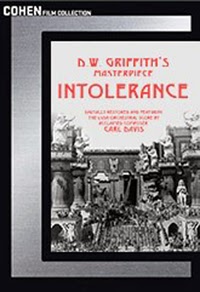By Steve D. Stones
The folks at Cohen Media Group have released a beautiful
digitally restored DVD and Blu-Ray print of D.W. Griffith’s 1916 silent epic
“Intolerance.” The DVD comes with a
booklet of information about the making of “Intolerance.” The film is the first
in Hollywood history to be called “epic” and innovative because of its use of
enormous sets, elaborate costumes and thousands of extras in crowd scenes - despite
the fact that no script had been written for the film.
“Intolerance” opens with a recurring image of a mother
rocking a cradle, played by Griffith regular Lillian Gish. Four stories are woven
together from different times in history - Biblical Judea, Medieval Paris,
Ancient Babylon and early 20th century America. Two of the stories –
The Mother & The Law (the early 20th century America story) and
the fall of Ancient Babylon can be seen as separate films on a second disc that
comes with the DVD, which is how director Griffith originally intended the four
films to be seen.
The Mother & The Law story deals with the injustice a
poverty stricken young mother goes through when a group of self-righteous
society women take her baby away because they feel she is unfit to care for the
child. The Biblical Judea story tells of Christ’s struggles with the Pharisees,
and ultimately his crucifixion. Medieval Paris tells of Charles IX of France
influence of his mother, Marguerite of Medici, to issue a decree against the
Huguenots, which results in the events of the St. Bartholomew’s Day Massacre on
the 24th of August 1572. The Ancient Babylon story is of the High
Priest of Bel who convinces the Persian King Cyrus to destroy and conquer Prince
Belshazzar in 539 BC.
In January to April of 1916, Griffith filmed the fall of
Ancient Babylon scenes, which are the most famous and legendary of the film.
With this story, he had built the largest, most spectacular sets ever made in
motion picture history up to that time. The interior shots of Ancient Babylon
are a truly breathtaking sight. The great Babylon set became legend in
Hollywood, and a replica was made near the Dolby Theatre as a backdrop for the
annual Academy Awards.
Still dealing with his critics after the release of “Birth
of A Nation” (1915), Griffith’s “Intolerance” also had its share of critics.
Griffith’s depiction of undraped women in Ancient Babylon times outraged some
critics and movie-goers. Some even suggested that the Mother & The Law
story was an attempt to show how the wealthy and powerful try to impose rigid
standards of morality on the poor class.
Upon its initial release, movie-goers flocked to see
“Intolerance” in 1916. However, after just a few short weeks, attendance
started to drop. Considered a “box office failure” at the time, the film
suffered mostly from the huge expenses lost from promoting the film. Today, it
is regarded as one of the most important films in early Hollywood history, if
not the most important.
A number of worn out, public domain prints can be found for sale of "Intolerance" in the movie marketplace. Avoid these prints at all costs. It is worth the extra money for the serious film collector to invest in this print put out by Cohen Media Group. Happy Viewing!

No comments:
Post a Comment